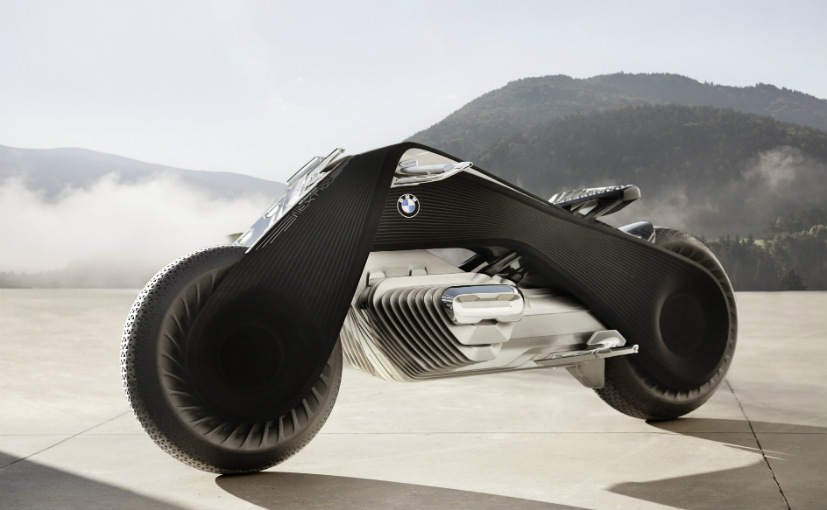BMW has revealed its long-term vision for its motorcycle division, BMW Motorrad. The company revealed the concept model of the Vision Next 100. The motorcycle is so technologically advanced that, in theory, it would not be necessary to wear a helmet when driving it.
The Motorcycle
The model is an entire redesign from the concept of a motorcycle. For example, the Vision Next 100 does not need any kind of suspension, thanks to BMW’s self-coined Flexframe technology. Instead, the two wheels are designed to absorb all shocks and bumps. For steering, instead of the front wheel changing direction through a pivot, the entire frame changes shape in order to realise the course of direction. Most prominently, the motorcycle houses several technological features that allow the motorcycle to never fall over. This feature adds a great deal of safety to riders of all experience levels. Lastly, in line with BMW’s overall target of increasing environmental sustainability, the conceptual model is based on a zero-emissions technology.
The Wearables
BMW’s technology implementations do not stop at the motorcycle itself. The rider is also immersed in technological novelties. Literally. The gear is divided in two parts: a bodysuit and a visor. As there is no risk of tipping over, the bodysuit is very light and the visor does not need to have a helmet component.
The visor is able to display all kinds of data to the rider, depending on the situation on the road and where the rider is looking. For example, regarding distraction issues, data displays are brought to a minimum when the rider looks straight ahead. When the rider looks up, however, a camera mounted at the back of the motorcycle will allow the rider to view what is happening behind him or her. Also, the display will alert the rider of road hazards and it will propose suitable approaches to turns. If the rider does not adhere to the suggestions and is risking an unsafe approach to a turn, the bike will correct its positioning itself in order to prevent a crash.
The bodysuit also mainly serves as a conveyer of information. Besides the more traditional functions of keeping the temperature of the rider on a suitable level and providing support to the body during long journeys, the suit also allows navigation to work through the suit. For example, vibrations in the right arm signal the need to turn right, and the other way around for the left arm.
The Vision
Although the extensive implementations of technology make it seem like BMW is going towards self-driving motorcycles, their actual goal is the exact opposite. Everything to add, every feature they implement, is to empower the rider to fully experience the forces unleashed when riding a motorcycle. Free from restrictive gear and enabled by technology to fully commit to a perfect riding experience. So, very different from the car industry’s destination focus, BMW’s vision is fully geared towards enhancing the journey itself. With the synergy between man, tech and machine, getting from A to B has gotten a lot more exciting.
References:
Howard, B. (2016). BMW’s 100-year vision: a smart motorcycle that won’t tip or crash | ExtremeTech. [online] ExtremeTech. Available at: http://www.extremetech.com/extreme/236446-bmw-vision-next-100-smart-motorcycle [Accessed 14 Oct. 2016].


Hey Christiaan,
Although I would like the concept of what BMW proposes I do not see it happening in the near future. BMW might have the technological advance of creating a super safe bike, but the legal issues won’t change that fast.
A common issue now that technology is changing so fast, is that it is not in line with old laws (http://fortune.com/2016/07/08/technology-new-legal-problems-littler-mendelson/). Before these laws change, technology might have further developed itself or other companies have copied the startegy of, in this instance, BMW.
How would you see BMW adapting to the legal issues?
Dear Christiaan,
Thank you for the great post! I saw this the moment it came out and although its a great idea it has received a lot of criticism from the public for one good reason.
BMW is aiming to create the perfect motorcycle, a motorcycle that makes no mistakes but unfortunately for them we live in a world full of mistakes and randomness. Even if the motorcycle had all the information about its surroundings and could predict things such as weather patterns, street composition, etc. There are still things it will never be able to predict.
Firstly, there are other drivers. How can an automated system predict the behaviour of a non-autonomous driver. The driver may even choose to crash the biker on purpose and the system would not be able to react on time.
Lets say that in 100 years all cars are automated and part of an intelligent neural network which allows them to understand each other and avoid collisions. This would technically eliminate the first problem but the beauty of biking is not to stay in a city or a place with lots of other cars.
A big majority of bikers prefer to go to rural areas where they can really experience freedom. In this case you are exposed to a completely uncontrollable factor. Nature. What happens if a deer jumps out of nowhere? or if a bird collisions with your bike? Nature is something we will never be able to fully control.
BMW’s concept assumes that with this technology we will not need helmets anymore. In my opinion the concept of not falling as much as before is a possibility but a helmet will save you in most situations no matter how automated or not they are. We will see how this concept evolves, maybe they make it work but it will take a long time for people to adapt to such a new way of riding.